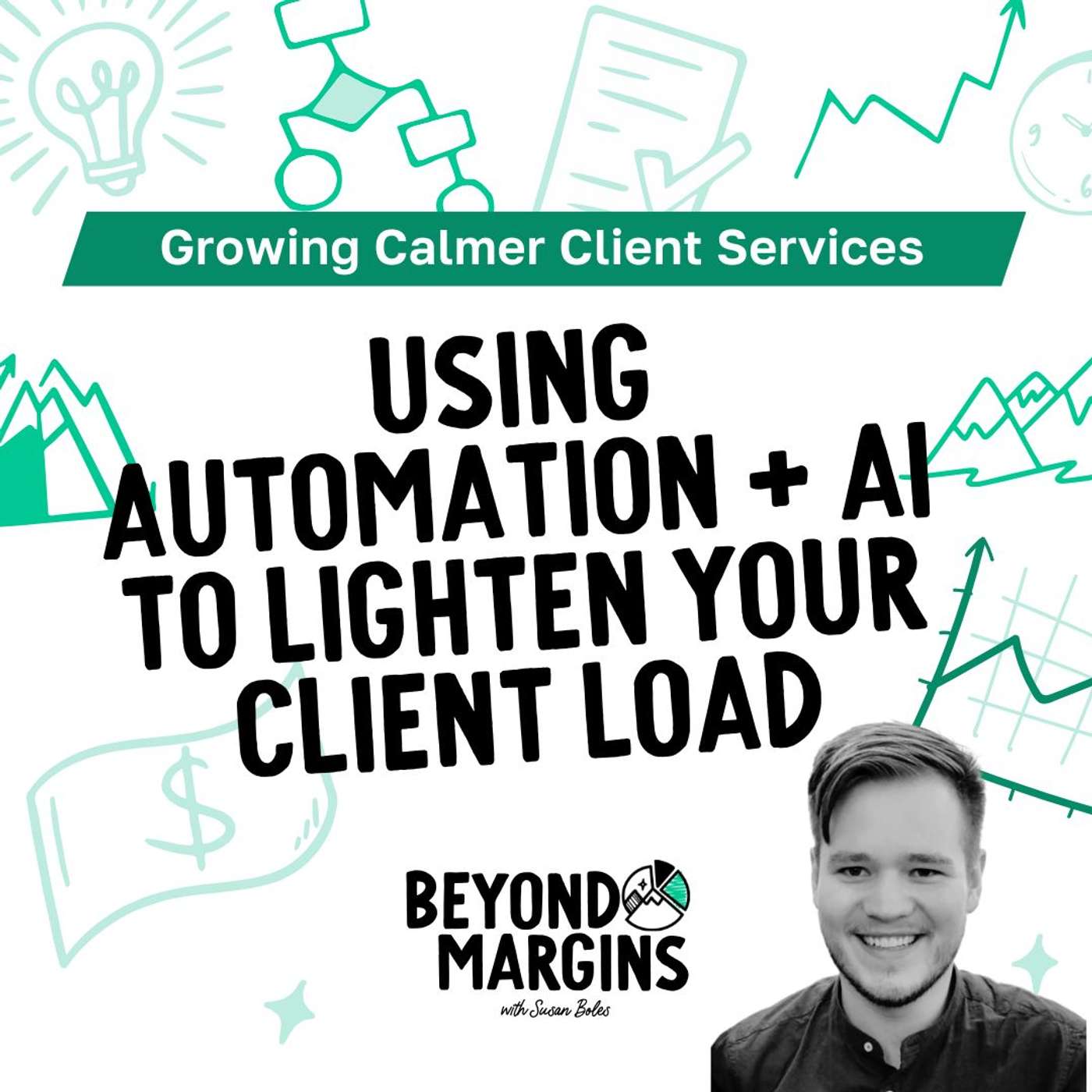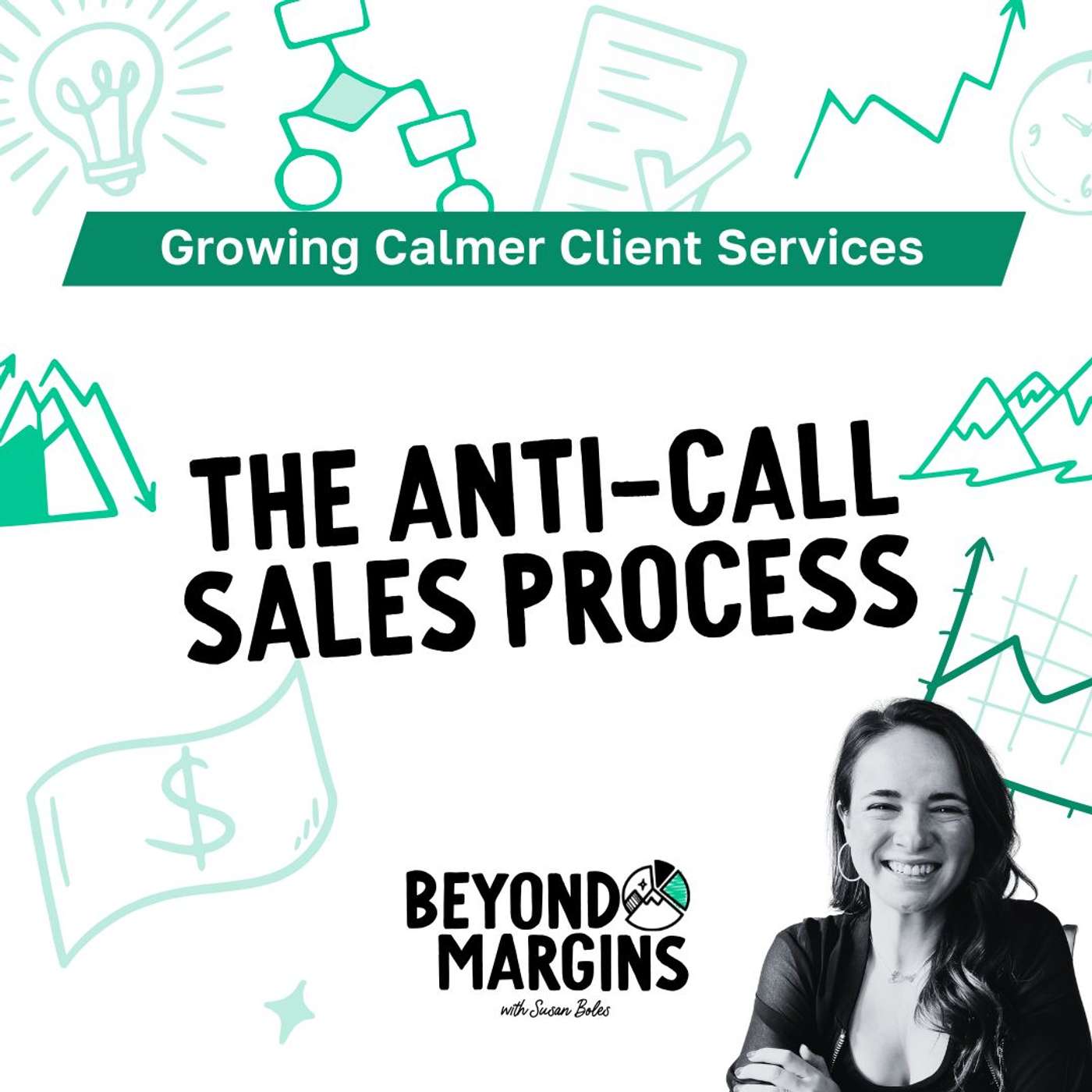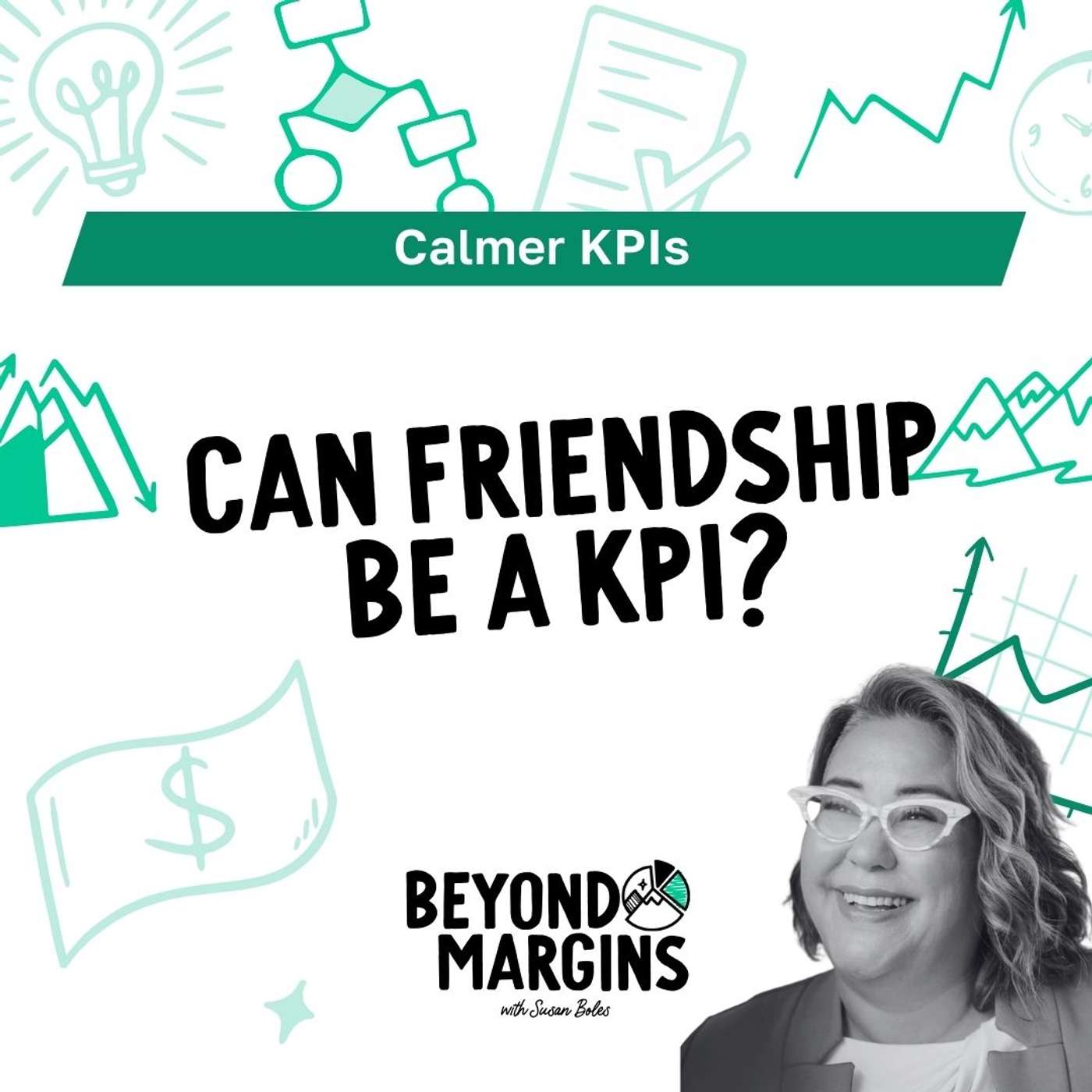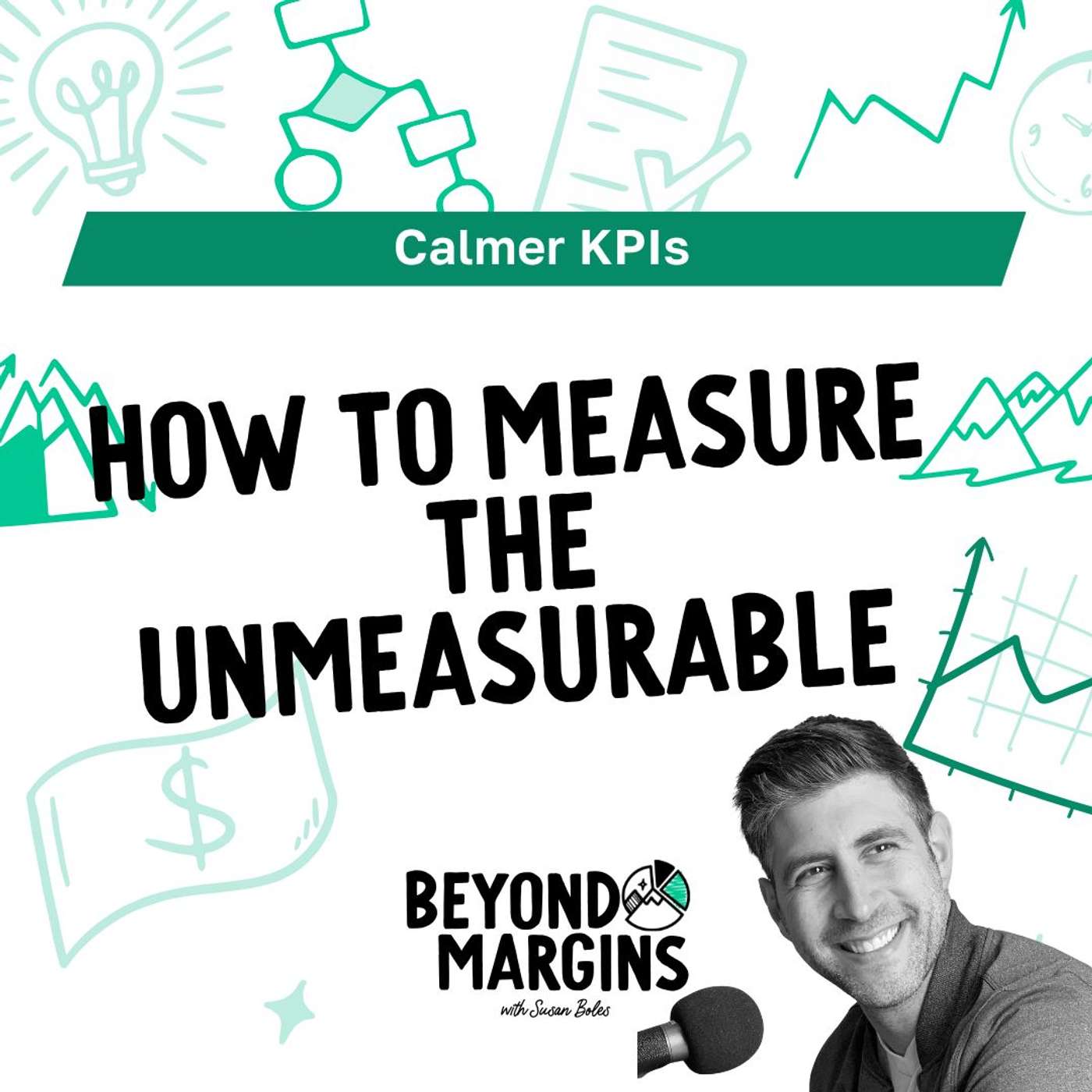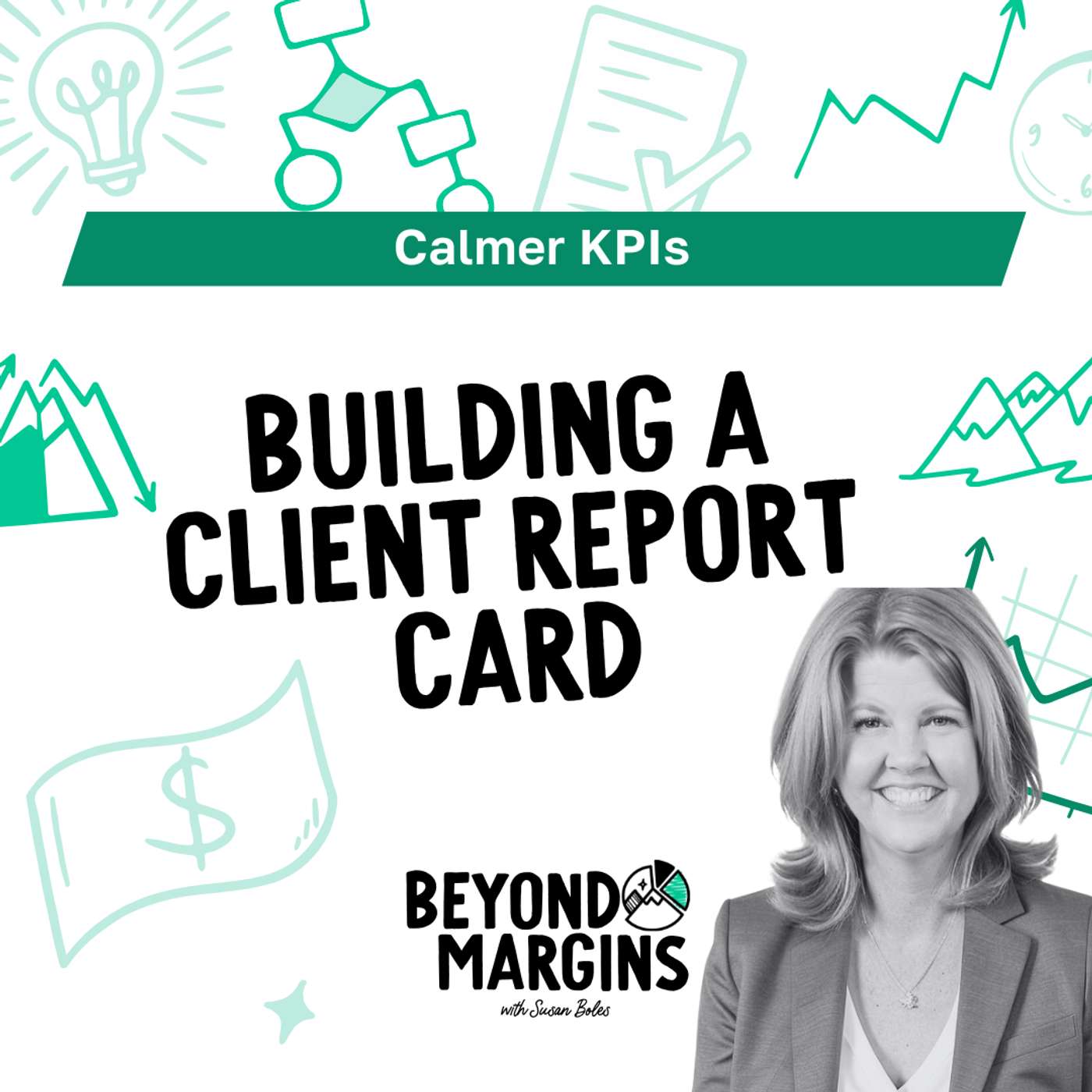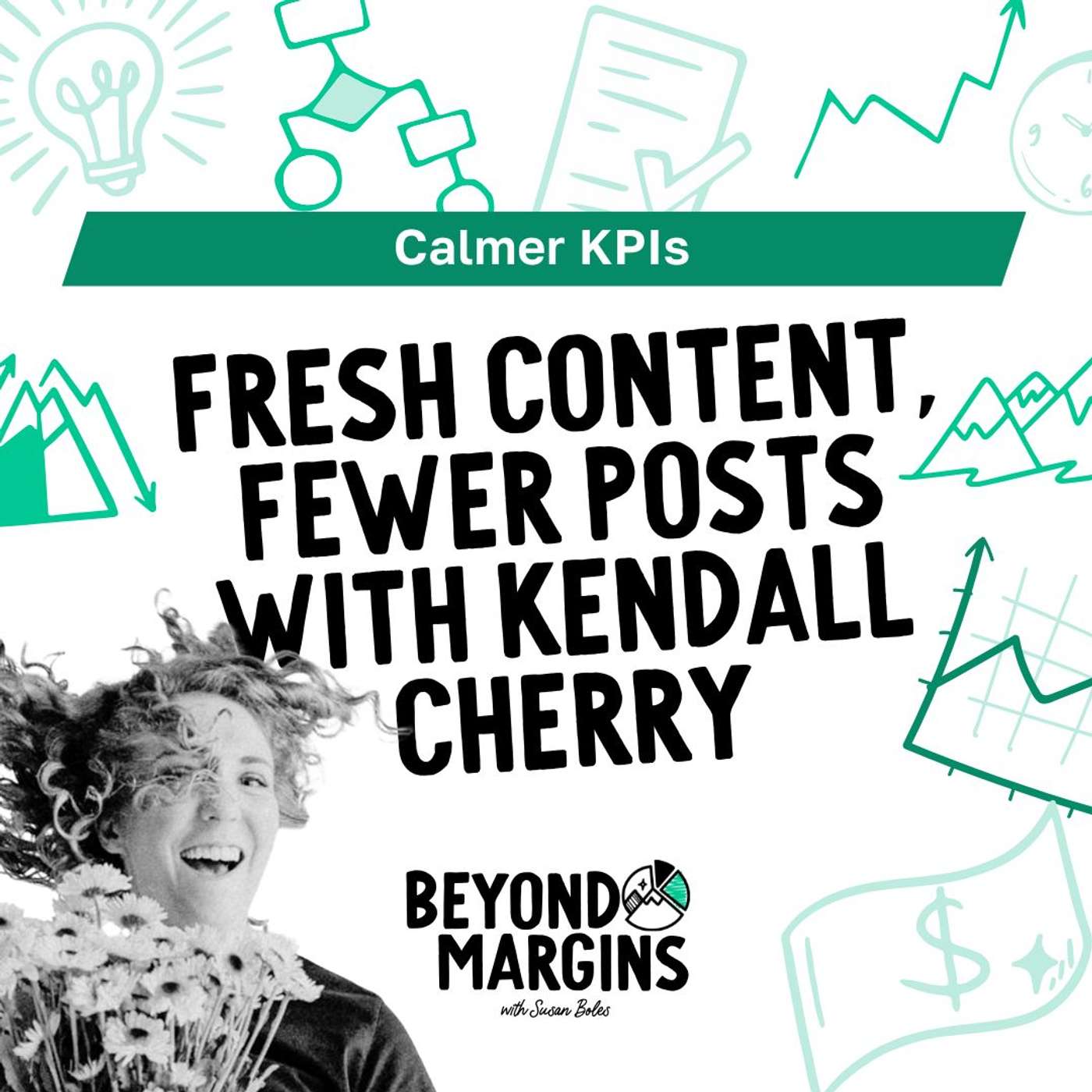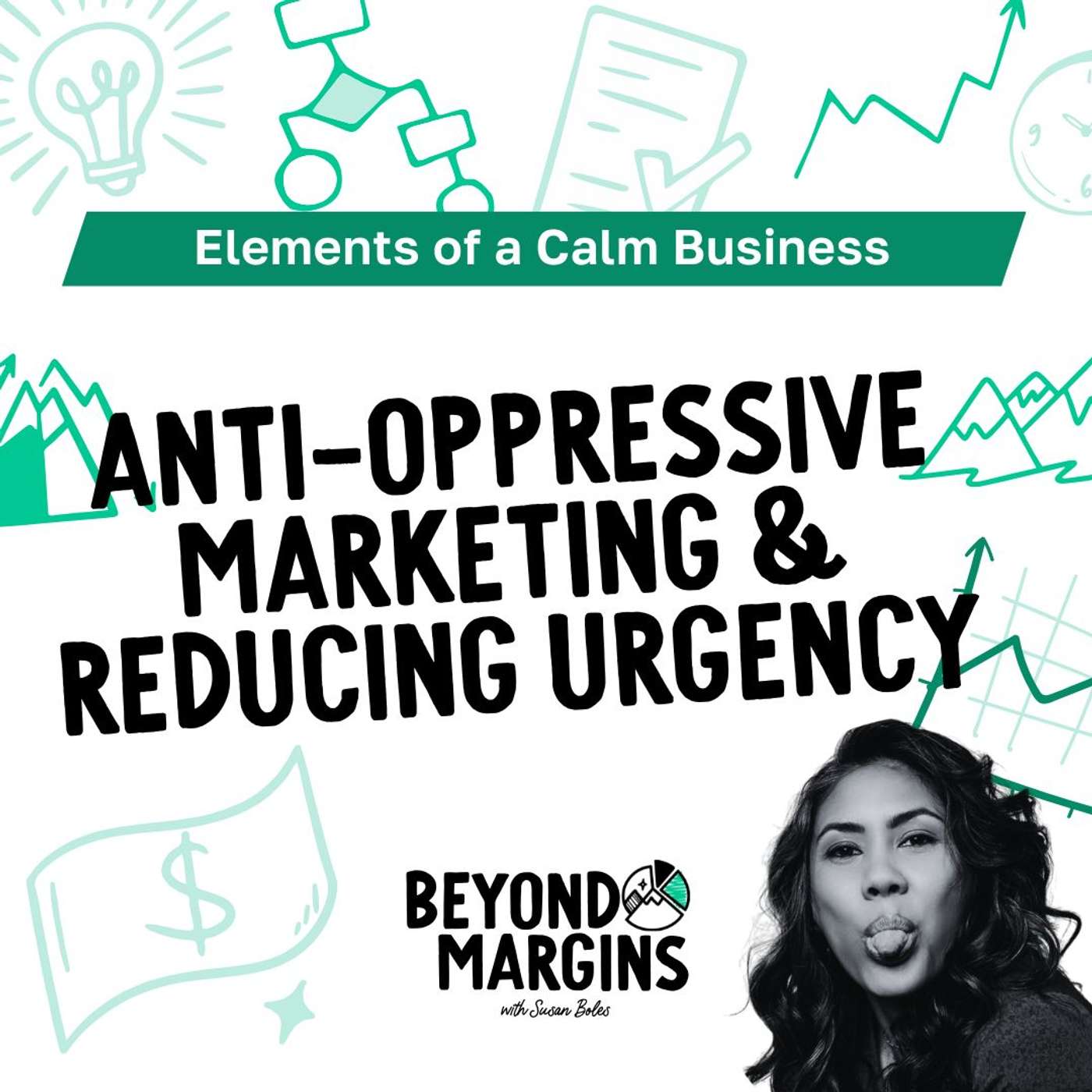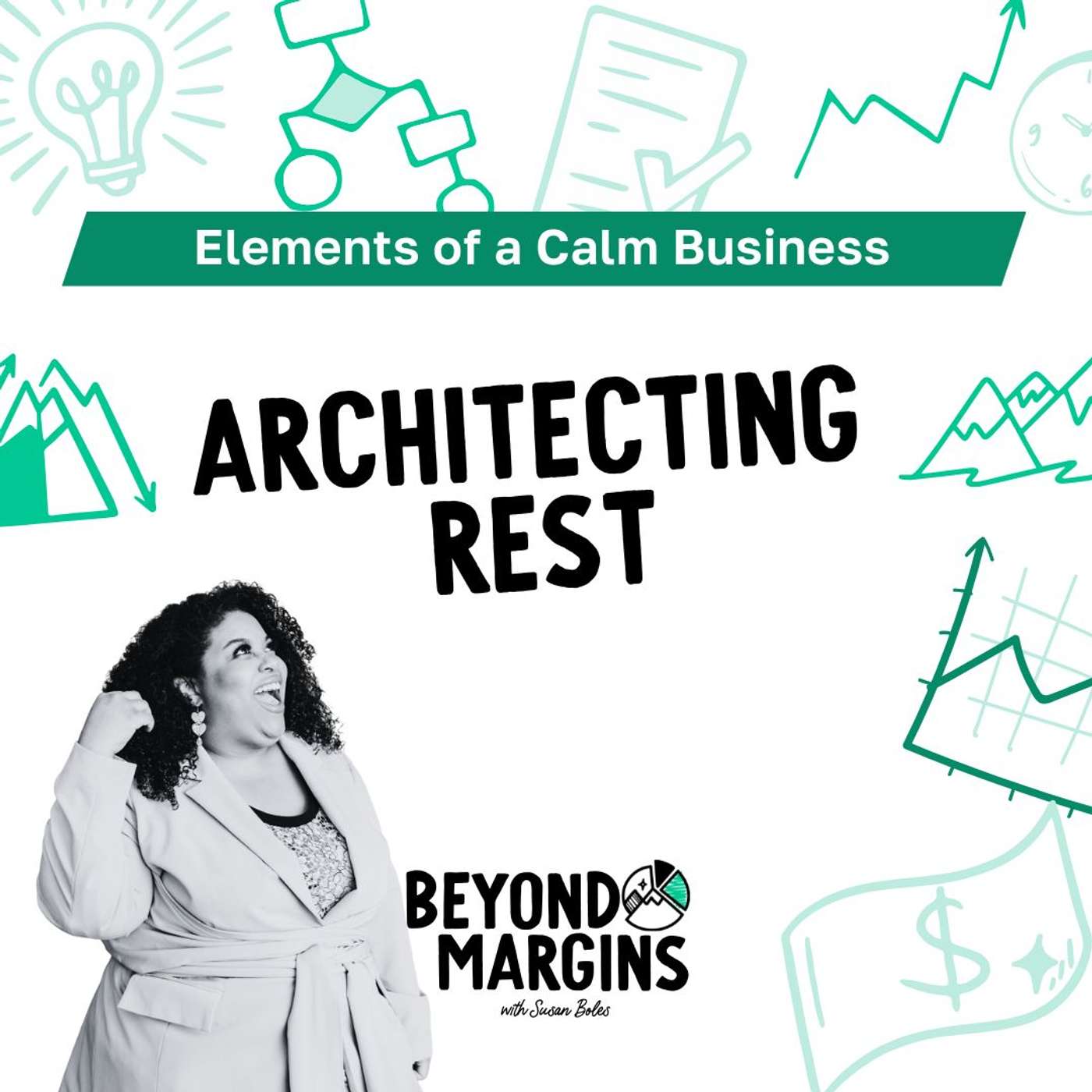Discover Engineering Calmer Agencies & Consulting Firms: Calm is the New KPI
Engineering Calmer Agencies & Consulting Firms: Calm is the New KPI

Engineering Calmer Agencies & Consulting Firms: Calm is the New KPI
Author: Susan Boles
Subscribed: 12Played: 600Subscribe
Share
© 2025 ScaleSpark, Inc. dba Beyond Margins
Description
Can you build a business based on… “calm?” Host Susan Boles looks beyond the usual metrics of success to help you build a business where calm is the new KPI. With over 15 years of experience as an entrepreneur, CFO, and COO, Susan shares the business strategies that lead to a business with comfortable margins—financial, emotional, energetic, and scheduling margins. Join her and her guests as they counter the prevailing “wisdom” about business growth, productivity, and success to provide a framework for making choices that align with your values and true goals. Episode by episode, you’ll get a look at the team management, operations, financials, product development, and marketing of a calmer business.
129 Episodes
Reverse
After 11 years, Tanya’s business hums. She's got warm leads, proven offers, talented contractors. And yet… projects that should take two weeks stretch to two months because she’s the translator between client and designer. In this live diagnosis, we map a transition from “Tanya-as-critical-path” to a productized, reliable service with automated coordination, a structured client-feedback loop, and clear handoffs. We also unpack the fear behind delegating client trust - and why productizing increases value rather than commoditizing it.What You’ll LearnHow to design a Coordination Offload System so delivery runs without you in the middleA simple, automated client-feedback flywheel (template email + form + status trigger)Why productizing raises reliability and margin without lowering priceWhere to add a copywriter or coordinator—and where automation beats headcountA tiny, 90-minute action that can save 3–4 hours every month (and unstick cash flow)Connect with TanyaConnect with Tanya on LinkedInCheck out Moushi & Co
(00:00) - Introduction: The Bottleneck Dilemma
(00:47) - Meet Tanya Moushi: The Expertise Trap
(01:39) - Identifying the Bottleneck
(04:24) - Strategizing the Transition
(08:08) - Implementing Systematic Solutions
(40:03) - Conclusion: Creating Reliable Systems
Grab the Calm Service Design + Delivery Swipe File here
Meetings don’t equal management—most of the time, they’re just control theater. Freelance project manager Kacie Brennell joins Susan to unpack how autonomy—not attendance—drives real outcomes. They dig into async accountability, why tools fail without culture shifts, and how perfectionism + codependency quietly sabotage calm. If you’ve ever looked up from a day of calls with a longer to-do list, this one’s for you.What you’ll learnHow to shift from presence-driven management to outcome-driven autonomyThe simple async cadence: owner → outcome → deadline → 3-bullet updateWhy software alone won’t save you (and what culture change must come first)Spotting perfectionism and codependency at work—and what to model insteadHow to use efficiency to create margin (and then actually keep it)Practical scripts for moving “quick calls” into written, visible decisionsConnect with KacieConnect with Kacie on LinkedIn
(00:00) - Introduction: The Myth of Meetings
(00:55) - Guest Introduction: Kacie Brenell
(01:13) - The Importance of Autonomy in Work
(03:16) - Challenges and Solutions in Modern Work Culture
(05:50) - The Role of Technology and Tools
(42:38) - Conclusion: Embracing CALM Management
Check out the SOP Swap at ProcessDriven
What if your most important KPI wasn’t about revenue, leads, or efficiency—but about people? In this episode, operations strategist Layla Pomper shares the story of her Death List KPI: a surprisingly human metric born out of emergency planning that reshaped her entire approach to resilience.What started as a morbid exercise—writing down who her partner should call if she died—became a powerful reframe. It forced Layla to measure not just internal systems, but the strength of her external relationships. The result? A business that’s not only operationally sound, but relationally resilient.What You’ll LearnWhy a Death List KPI matters more than a perfectly documented SOP.How to structure your own list by category: legal, financial, operational, technical.The role of community as real business infrastructure.Why operators in particular need a stronger “village.”How one metric can cascade into redesigning your business model, marketing, and personal priorities.Learn More About Layla PomperCheck out ProcessDriven on LinkedInCheck out ProcessDriven on YoutubeProcessDriven.co
(00:00) - Introduction: The Importance of a Death List
(00:38) - Layla Pomper's Realization and Shift
(01:43) - Defining the Death List
(02:53) - Building a Resilient Business Community
(05:08) - Implementing the Death List in Business Operations
(35:29) - Conclusion: The Power of Community
Check out the SOP Swap at ProcessDriven
When your signature skill is the thing clients line up for, it’s easy to accidentally build a beautiful trap. In this live diagnosis, Jeremy Enns, the founder of Podcast Marketing Academy,shares how his rave-review podcast audits started running his weeks (and energy) into the ground. We focus on Business Design and Margin Mindset to keep the magic intact while redesigning delivery so results scale and burnout doesn’t. Think: fewer audits, higher prices, phased delivery, and using your audit as a kickoff to a year-long, calm growth arc.What You’ll LearnWhy splitting “the thinking” across multiple people weakens synthesis - and what to do insteadA calm way to productize deep expertise: shorter delivery, phased implementation, clearer prioritizationHow to reframe audits from one heavy drop to a year-long outcomes programPricing and packaging tweaks that filter for fit and reduce overwhelmUsing “show, don’t tell” proof (full audit shares/teardowns) to communicate outsized valueLearn More About Jeremy EnnsConnect with Jeremy on LinkedInJeremy’s site: podcastmarketingacademy.comFree Podcast Marketing Audit: podcastmarketingacademy.com/auditNewsletter — Scrappy Podcasting: podcastmarketingacademy.com/scrappy-podcasting-newsletter
(00:00) - Introduction: The Dream and the Trap
(00:56) - Case Study: Jeremy's Podcast Audit Process
(05:53) - Challenges and Solutions: Scaling Expertise
(23:50) - Communicating Unique Value
(27:55) - Structuring Value Delivery
(35:09) - Optimizing Business Design
Grab the Calm Service Design + Delivery Swipe File here
If you've been sharing the same ideas for years but still feel like you're reinventing the wheel every time you explain them, this episode is for you. Susan sits down with Melanie Deziel, creator of the IRON Framework, to explore how to transform raw, unstructured ideas into scalable, repeatable frameworks. Go behind the scenes of the Calmer Framework’s evolution, explore why naming comes last, and show how frameworks can become the backbone of your services, content, and operations. Whether you’re trying to clarify your IP or reduce your mental load, this episode will help you treat your ideas like infrastructure.What You’ll Learn:Why lack of structure - not lack of clarity - is holding your IP backThe four components of Mel’s IRON Framework for turning ideas into frameworksHow systematizing your thinking creates business leverage and marginThe difference between creativity and reinventionWhy framework development is more collaborative than you thinkLearn More About Melanie Deziel: Melanie Deziel is a keynote speaker, author of The Content Fuel Framework, and the founder of StoryFuel. She helps entrepreneurs and organizations transform their ideas into scalable content and IP.Website: https://www.melaniedeziel.comFramework Development Cheat SheetLinkedIn: Melanie DezielLearn More About Susan Boles + Beyond Margins:Website: https://www.beyondmargins.comLinkedin: Susan Boles
(00:00) - Introduction: The Problem with Unstructured Ideas
(01:19) - Frameworks as a System
(02:29) - The Importance of Consistent Messaging
(20:36) - The Evolution of Frameworks
(24:33) - Collaborative Framework Development
(31:13) - Implementing and Scaling Frameworks
Grab the Calm Service Design + Delivery Swipe File here
Susan sits down with leadership and culture consultant Melissa Carson to tackle a challenge so many entrepreneurs face: digital tool sprawl. Together, they unpack the overwhelm caused by scattered systems and explore how creating a single source of truth—your personal data warehouse—can unlock mental clarity and free up energy for more meaningful work.Melissa shares her struggles with multiple overlapping tools (Google, Microsoft, Airtable, and more) and the mental load of duplicated content workflows. Susan guides her through the process of consolidating tools, designing for ease, and building a system that actually supports her business rather than drains it.Whether you’re drowning in Google Docs, lost in Notion, or stuck juggling endless spreadsheets, this episode offers a roadmap to a calmer, more intentional business setup.What You’ll LearnHow a “personal data warehouse” can transform your content and client operationsWhy choosing the right tool isn’t about features, but about how it feels and supports your brainThe power of building a single source of truth to reduce decision fatigueHow to leverage automation to reclaim time and mental energyPractical first steps to start consolidating and simplify your systemsLearn More About MelissaCanopy Strategies WebsiteConnect with Melissa on LinkedIn Learn More About SusanBeyond Margins websiteConnect on LinkedIn
(00:00) - The Power of a Centralized Digital Brain
(01:51) - Meet Melissa Carson: A Case Study in Digital Overwhelm
(02:30) - Diagnosing the Bottlenecks: Tools and Redundancies
(04:37) - Strategies for Building a Personal Data Warehouse
(21:37) - Consolidation and Efficiency: Steps to a Calmer Business
Find out more about Calmer Brain by grabbing a copy of the Beyond Margins Services Guide
This episode is part 2 of a 2-part conversation with Joe Casabona, a systems architect for solopreneurs and a self-described automation geek. You can catch part 1 over on the Streamlined Solopreneur feed hereWhat if the difference between a chaotic, scope-creeping project and one delivered calmly, on time, and on budget wasn’t just better estimating - but a totally different approach? Joe shares how he used "vibe coding" - collaborating with AI as a coding partner - to rescue a complex nonprofit website project from spiraling out of control. You’ll hear how he navigated unexpected technical requirements, avoided burning weekends, and delivered a solution that protected both his business and his mental health.This isn’t about working faster. It’s about designing a system that supports calm, margin, and intentional business choices.What You’ll LearnHow "vibe coding" can help consultants keep projects on track without endless late nightsThe importance of deeply understanding client needs (and what happens when you don’t)Why AI is a better "rubber duck" than a magic wandHow to approach AI as a partner rather than a replacementPractical ways to use AI to reinforce your business values and protect your timeLearn More About JoeJoe Casabona’s websiteStreamlined Solopreneur podcastLearn More About SusanBeyond Margins websiteConnect on LinkedIn
Find out more about Calmer Brain by grabbing a copy of the Beyond Margins Services Guide
What if the reason you're stuck isn't mindset—or even procrastination? What if you're just solving the wrong problem?In this episode, I’m talking with Cat Mulvihill, creator of the Momentum Framework—a diagnostic tool that helps you figure out exactly why you’re stalled out in your business and what to do about it. Whether the block is a skills gap, an energy mismatch, or a lurking fear, Cat’s approach helps you pinpoint the true cause so you can move forward without forcing it.We explore why momentum doesn’t need to be forced—and how understanding your method, mode, and mindset can make everything feel a whole lot easier.What You’ll Learn:The three core bottlenecks that block momentum—and how to diagnose themWhy systems that work with your brain create more sustainable progressThe surprising downside of perfectionism and "Cadillac" toolsHow fear masquerades as procrastination (and how to call it out)Practical examples for redesigning your systems to match your energy and contextLearn More About Cat: WebsiteFollow Cat on LinkedInThe Momentum FormulaMore from Susan:Follow Susan on LinkedIn 💌 Get weekly calm business insights at beyondmargins.com/newsletter 🛠 Explore services: beyondmargins.com
Find out more about Calmer Brain by grabbing a copy of the Beyond Margins Services Guide
What if your brand voice didn’t live solely inside your head? What if it was a system—a tool that helped you write faster, delegate confidently, and create calm across your business?In this episode, I share how I took my brand voice from “just a vibe” to a repeatable, documented system with the help of voice strategist Justin Blackman. We dig into how building a voice guide changed the way I write, collaborate, and scale. If content creation feels like a bottleneck—especially when you're not the one doing the writing—this episode is for you.We’re not just talking about voice—we’re pulling two big levers from the CALMER framework:→ Efficiency, by turning intuition into reusable tools → Management Style, by empowering your team with clarity instead of correctionsThis is a behind-the-scenes look at the system that helped me put my voice on autopilot—and made content creation calmer, faster, and more fun.What You’ll Learn:Why “no one can write like me” is a sign you need a system, not more effortThe three components of a brand voice (and why most guides get it wrong)How defining the difference between you and your brand prevents burnoutWhy “authenticity” doesn’t have to mean writing everything yourselfLearn More About Justin BlackmanWebsite: justinblackman.comGrab Justin's Feelings WheelLinkedIn: Justin BlackmanLearn More About the Host – Susan BolesWebsite: beyondmargins.comLinkedIn: Susan BolesSubmit your Calm KPI or System: Send it here
(00:00) - The Subjective Nature of Brand Voice
(00:50) - The Challenge of Maintaining a Consistent Brand Voice
(01:51) - Building a Scalable Voice System
(04:41) - The Science Behind Brand Voice Guides
(09:28) - Balancing Personal and Brand Identity
(29:34) - Leveraging AI for Authentic Brand Voice
Find out more about Calmer Brain by grabbing a copy of the Beyond Margins Services Guide
Most advice about scaling a service business means giving up the work you love or cranking your rates until clients walk away. But what if you could grow your revenue with your clients—without adding more to your plate? In this episode, Susan revisits a standout 2019 interview with business coach Lacey Sites, who doubled her revenue without taking on a single new client.Lacey did it by shifting to a revenue-sharing compensation model—one that ties her income directly to her clients’ success. In this re-edited version, we dive into how that shift happened, what she tested first, how she vets clients to make the model work, and why it changed everything about how she runs her business.What You’ll Learn:Why default pricing models for service businesses often lead to misaligned incentivesHow Lacey experimented with and validated her revenue-sharing structure before going all inWhat criteria she uses to select high-commitment, high-potential clientsWhy adding a base rate created a healthy balance between risk and rewardHow this model enabled Lacey to scale with her clients—and why it feels more equitable for everyone involvedLearn More About Lacey Sites:A Lit Up LifeWant to design your own calm-aligned pricing model? 📁 Grab the Calmer Service Design Swipe File with 60+ examples 💬 Or check out Susan’s 1:1 support options
(00:00) - Introduction: The Problem with Traditional Pricing Models
(01:01) - A New Approach: Revenue Sharing Model
(01:30) - Case Study: Lacey Sites' Success Story
(02:51) - Lacey's Journey to Revenue Sharing
(05:30) - Implementing the Revenue Sharing Model
(08:03) - Client Selection and Vetting Process
(14:45) - Balancing Risk and Reward
(21:31) - Scaling and Future Plans
(29:05) - Conclusion: Designing a Calmer Business
Grab the Calm Service Design + Delivery Swipe File here
Tired of hitting a wall with your client-based business? You don’t have to build a course or start a membership to scale. In this episode of Calm is the New KPI, host Susan Boles talks with Janet Alexandersson—an international licensing lawyer and founder of Piggy Bank Legal—about how licensing can become a powerful, margin-creating revenue stream for service-based business owners.If you've ever wondered how to productize your existing client work without burning out or shifting your entire business model, this episode is your permission slip. Janet walks us through the practical, strategic, and protective aspects of licensing, and shares how this often-overlooked business lever can change how you earn, design, and rest.What You’ll LearnWhat licensing actually is—and why it's not just for tech or big corporationsThe step-by-step process to start licensing your existing IPCommon pitfalls to avoid in licensing deals (and how to protect yourself)Why pricing should reflect their value, not yoursHow licensing can support a hybrid model with clients and passive incomeLearn More About JanetPiggy Bank LegalLinkedInLearn More About SusanBeyond MarginsLinkedIn
(00:00) - Introduction: The Struggles of High-Touch Client Work
(01:21) - Exploring a New Revenue Stream: Licensing
(02:16) - Understanding Licensing with Janet Alexander
(05:35) - The Licensing Process: Step-by-Step
(10:18) - Protecting Your Intellectual Property
(19:58) - Real-World Licensing Examples
(38:49) - Final Thoughts on Licensing and Business Design
Grab the Calm Service Design + Delivery Swipe File here
You’ve duct-taped your service business together with tools and automations. But now things are breaking, you’re chasing Zapier errors, and client delivery is starting to feel like a drag. What if the next step wasn’t hiring a team or flattening your services—but turning your system into the service?In this episode, we're geeking out with Dylan Kinder, founder and CEO of DataCose, about how service-based businesses can scale by transforming parts of their delivery into software. We explore how to spot the signs that you’re ready to make that shift, where to start, and why automation and AI don’t have to mean less human work—just less draining work.Whether you’re dreaming of fewer tabs, smoother client onboarding, or a more proactive delivery experience, Dylan brings a thoughtful, non-spammy approach to scaling with tech. We’re diving deep into internal vs. client-facing tools, the role of AI in small business, and how to avoid building a digital Frankenstein.What You’ll Learn:The two biggest signals it’s time to turn part of your service into softwareWhy internal automation is the best starting pointHow to think like an engineer (even if you're not one)The role of client portals in scaling calm service deliveryWhy AI should be used with human oversight—not instead of itConnect with Dylan:LinkedIn DataCoseConnect with Susan: LinkedInBlueSkyWork With Susan: Explore how we can build calm systems together → https://beyondmargins.com/services
(00:00) - Introduction: The Struggles of Scaling a Service Business
(00:43) - Reimagining Service Delivery with Smart Systems
(02:12) - Exploring Automation and AI with Dylan Kinder
(03:06) - The Two Paths to Scaling a Service Business
(10:28) - Real-World Examples of Successful Automation
(24:33) - The Role of AI in Modern Service Businesses
(34:35) - Conclusion: Building Margin and Calm with Technology
Grab the Calm Service Design + Delivery Swipe File here
Eliminate Sales Calls? Yes, Really.What if your entire sales process could feel human, high-touch, and not require a single call?This week on Calm is the New KPI, I’m joined by Becky Pierson Davidson, founder of Affinity Collective, a product strategy agency for community-driven businesses. Becky shares how she’s turned the traditional, time-consuming sales process on its head—closing $15K+ client engagements with zero sales calls.Instead of long proposal timelines, back-to-back Zooms, and ghosted bookings, Becky uses a thoughtful, asynchronous process: pitch decks, Loom videos, and warm DMs. The result? A system that respects her time, delights clients, and converts beautifully.We talk about:Why she ditched the “book a call” CTA after one too many no-showsHow to build a sales process that mirrors your service deliveryCreating personalized-but-repeatable Loom videos that sell for youBuilding referral relationships that actually workThe key role productized services play in making async sales possibleWhether you're an introvert, hitting a capacity ceiling, or just curious about doing sales differently, this episode is a must-listen.Learn More about Becky Pierson DavidsonAffinity Collective WebsiteConnect on Instagram or LinkedInSubscribe to her newsletter for community-driven strategy insightsLearn More about Susan BolesBeyondMargins.comCheck out the Services GuideFollow Susan on LinkedIn✨ Want a sales process that works while you sleep? We can design and implement your asynchronous sales system in a single-day intensive. Learn more at beyondmargins.com/services.
(00:00) - Introduction: The Sales Call Dilemma
(01:39) - Scaling a Client-Based Business
(02:04) - Eliminating Sales Calls: Is It Possible?
(03:16) - Guest Introduction: Becky Pearson Davidson
(05:12) - Becky's Asynchronous Sales Process
(11:57) - Building Trust and Customization
(37:43) - Final Thoughts and Takeaways
Grab the Calm Service Design + Delivery Swipe File here
Business is personal—so why do we so often separate relationships from our work? In this episode, Tara Robertson, leadership coach and DEI consultant, shares why she set a KPI around the number of new friends she makes this year. We explore how measuring relationships impacts not only joy but also business sustainability.Tara realized that working alone was draining her energy, so she made a bold decision: she would never go into an organization alone again. Instead, she’d co-lead, collaborate, and focus on working with values-aligned people who light her up. Now, she’s tracking new friendships as a key measure of success.Together, we dig into:Why business and friendship aren’t at odds (despite what the corporate world tells us)How Tara defines friendship vs. business collaborationThe impact of connection on work quality, creativity, and sustainabilityHow setting a friendship-based KPI brings more joy and alignment to business decisionsDifferent ways to track and measure relationships in your own workWhether you're an extrovert looking for more collaboration or an introvert like me, figuring out how to intentionally create relationships in business can be a game-changer.Connect with Tara: WebsiteLinkedInConnect with Susan: Beyond MarginsLinkedInBlueskyResources & Related EpisodesKaren Sargent on Client Report Cards
(00:00) - EDIT 2 / Final E114 Tara Robertson
(00:49) - The Importance of Friendships in Business
(01:28) - Setting KPIs for Friendships
(03:59) - Defining Friendships vs. Collaborations
(06:23) - Tracking and Measuring Friendships
(10:24) - Incorporating Friendships into Business
(15:01) - Balancing Professionalism and Authenticity
(25:40) - Conclusion: The Power of Connection
Grab the Calm Service Design + Delivery Swipe File here
We all want our work to resonate—but how do we know if it actually does? In this episode, I sit down with storytelling and speaking expert Jay Acunzo to explore the concept of resonance over reach and how we can track something that feels inherently unmeasurable. Jay shares his Unsolicited Response Rate (URR) framework, a KPI designed to measure whether your ideas truly connect with your audience. If you're tired of vanity metrics and want to focus on making an impact, this conversation is for you.What You’ll Learn in This Episode:What a KPI actually is—and why anything (even calm or resonance) can be oneHow to measure audience engagement beyond likes and followsJay’s URR (Unsolicited Response Rate) framework for tracking meaningful interactionsThe importance of putting in the reps before expecting resultsConnect with Jay: jayacunzo.comHow Stories HappenLinkedInBlueskyConnect with Susan: Beyond MarginsLinkedInBluesky
(00:00) - Introduction to KPIs and Calm as a KPI
(01:07) - Understanding Resonance with Jay Acunzo
(04:18) - Measuring Resonance: The URR System
(08:18) - Applying the URR System in Practice
(26:45) - Becoming Your Own Data Repository
(29:53) - Developing Resonance in Business
(34:13) - Embracing the Creative Process
Grab the Calm Service Design + Delivery Swipe File here
Managing client relationships is one of the biggest challenges of running a service-based business. Expectations, boundaries, and communication all play a role in whether an engagement runs smoothly or goes off the rails. So, how do you actually know if you're doing a good job?Karen Sergeant has a solution: a Client Report Card. This system helps her measure and manage client relationships proactively, identifying potential issues before they become problems. As a fractional COO, Karen has spent years refining this process to keep her work feeling calm—even when working inside chaotic businesses. In this episode, we break down her weekly client evaluation system—what metrics she tracks, how she uses the data, and how you can implement a similar approach in your own business. If you’ve ever struggled with scope creep, unclear expectations, or misaligned client relationships, this conversation is packed with insights that will help you create a calmer, more intentional business.What You’ll Learn in This Episode:Why Karen created her Client Report Card—and how it helps her businessThe 10 criteria she evaluates weekly to measure client relationshipsHow tracking qualitative vibe-based data helps prevent burnoutHow you can build your own Client Report Card to keep your business running smoothlyLearn more about Karen Sergeant: Karen's WebsiteConnect on LinkedinConnect on BlueSkyLearn more about Susan Boles:Beyond MarginsConnect on LinkedInConnect on BlueSky We value your thoughts and feedback. Feel free to share them with Susan here. Your input is not just valuable, it's crucial in shaping future episodes.
(00:00) -
(00:36) - Managing Client Relationships
(02:06) - The Importance of Boundaries and Scope
(08:31) - Karen's Report Card Criteria
(14:35) - Applying the Report Card in Business
Grab the Calm Service Design + Delivery Swipe File here
In this episode of Beyond Margins, we explore the concept of calmer KPIs with guest Kendall Cherry, founder of The Candid Collective. Kendall shares her innovative metric, “Fresh Content Inked,” and how it has transformed her content creation process, business systems, and sales cycle—all while doubling her income. We geek out about how to build sustainable systems that create spaciousness in your business, reduce overwhelm, and prioritize what truly matters.What You’ll Learn in This Episode: • What “Fresh Content Inked” is and why Kendall set a goal of writing six or fewer new pieces of content each month. • How building a content library can create a “maintenance mode” for your marketing and free up time for other priorities. • The benefits of an asynchronous sales process and how it aligns with calmer business principles. • Why posting less—and strategically repurposing content—can lead to better results and higher-quality client connections. • Kendall’s personal practices for staying creatively and emotionally balanced as a business owner.Learn more about Kendall CherryCheck out Kendall's NewsletterConnect on LinkedinLearn more about Susan Boles:Beyond MarginsConnect on LinkedInConnect on BlueSky We value your thoughts and feedback. Feel free to share them with Susan here. Your input is not just valuable, it's crucial in shaping future episodes.
(00:00) - Introduction to Calmer KPIs
(02:04) - Exploring Fresh Content Inked with Kendall Cherry
(11:15) - Building a Content Library
(18:01) - Impact on Sales and Business Strategy
(23:51) - Communicating Your Value Effectively
(24:47) - Building a Content Ecosystem
(26:58) - Leveraging Email Newsletters
(29:22) - Streamlining Sales and Client Management
Grab the Calm Service Design + Delivery Swipe File here
In this episode of Beyond Margins, Susan dives into the heart of goal-setting, breaking free from default metrics and focusing on what truly matters to your business and life. She shares her own approach to prioritizing calm as a core business metric and gives a behind-the-scenes look at how she set and tracked a single impactful goal in 2024—taking 12 weeks off to rest (spoiler: she surpassed it).Susan explores:Why default metrics like revenue targets may not align with your values.How to set meaningful goals rooted in your priorities.A practical framework for choosing Calm KPIs that guide your decisions.Why setting fewer goals—or none at all—can work for demand-avoidant or overcapacity business owners.Stay tuned for the rest of the series, where Susan will share insights from other business owners about their Calm KPIs, including an upcoming live workshop to develop a custom KPI for one business.What You’ll Learn in This Episode:The pitfalls of measuring default metrics that don't serve your goals.How Susan structures her business to prioritize rest and calm.Tips for evaluating and tracking your progress towards intentional goals.Real-world examples of unconventional metrics driving success in calmer businesses.Support the Show:Love Beyond Margins? Support the podcast by leaving a rating and review wherever you listen. Your feedback helps others discover the show and empowers us to continue sharing valuable insights.
Grab the Calm Service Design + Delivery Swipe File here
How do you reduce urgency in a world where urgency is so deeply embedded? How do you market yourself and your work in a way that is anti-oppressive? We're continuing in our mini-series on my calmer framework for a calmer business. This week, we're focused on reudcing urgency and techniques for anti-oppressive marketing. We're joined by Natalia Sanyal, an anti-oppressive copywriter and brand messaging strategist. She’s worked with billion-dollar businesses like Apple and Lululemon, New York Times bestselling authors like Layla Saad & Deepak Chopra, and award-winning marketing agencies. Now, she teaches high-integrity personal brands to use marketing as a force for good so they can sell better and harm less.On this episode, we learn some techniques to reduce urgency in our work, align actions with values to foster a calmer atmosphere for you, your team, and your business. Listen to the Full Episode to Hear:How can you move away from the default urgency-driven model?How can you reduce client emergencies and create more flexibility?What are the real-world applications of aligning business actions with values?How does embracing vulnerability play into the human aspects of entrepreneurship?Learn more about Natalia SanyalCheck out Natalia's newsletterConnect on LinkedinLearn more about me, Susan Boles:Beyond MarginsConnect on LinkedInConnect on Threads We value your thoughts and feedback. Feel free to share them with Susan here. Your input is not just valuable, it's crucial in shaping future episodes.
(00:00) - Introduction to Human-Centered Entrepreneurship
(00:55) - The Elements of a Calm Business
(01:40) - Reducing Urgency in Business
(03:03) - Anti-Oppressive Marketing with Natalia Sanal
(24:51) - Embracing Anti-Oppressive Marketing
(26:20) - Taking the Leap: Transitioning to Value-Aligned Clients
(31:19) - Deconstructing Urgency in Business
(37:47) - Building a Calmer, Sustainable Business
Grab the Calm Service Design + Delivery Swipe File here
We live in a society obsessed with productivity and working more, so how can we lean into rest? What are the benefits of building rest into our businesses? And how can we begin to do that? We're continuing in our mini-series on my calmer framework for a calmer business. This week, we're focused on rest. Rest is often a challenge for us go-getters, solopreneurs, and entrepreneurs. But, it's essential to stop burnout, stay creative, and have a truly calm and sustainable business. We're joined by Jordan Maney, a Radical Joy Coach™ and creator of the Radical Joy Collab who shares how we can build a rest ethic alongside our work ethic. She coaches others to learn the radical practice of rest so they can bring their visions to life. She’s been featured in New York Magazine, Yahoo, Attn, Oprah Magazine, and Martha Stewart Living.On this episode, we learn how to design our work systems to include rest in a way that works for each of us, how to push back on scoetal pressure to not rest, and how our work lives and personal lives can be transformed with the power of rest. Listen to the Full Episode to Hear:How can rest be intentionally designed and built into a business to make it calmer and more sustainable?Why is rest a critical element of productivity and how does it contribute to better creative work?What does a rest ethic look like and how can it be developed alongside a work ethic?Learn more about Jordan Maney:Check out Jordan's WebsiteConnect on InstagramConnect on LinkedinLearn more about me, Susan Boles:Beyond MarginsConnect on LinkedInConnect on Threads We value your thoughts and feedback. Feel free to share them with Susan here. Your input is not just valuable, it's crucial in shaping future episodes.
(00:00) - Introduction to Rest Ethic
(00:51) - Exploring the Importance of Rest
(01:44) - Challenges and Personal Experiences with Rest
(05:42) - Developing a Rest Ethic
(22:21) - Understanding Your Needs and Accommodations
(25:36) - Challenges of Implementing Rest in Work
(29:44) - The Importance of Rest and Its Impact
(37:58) - Practical Steps to Incorporate Rest
Grab the Calm Service Design + Delivery Swipe File here



